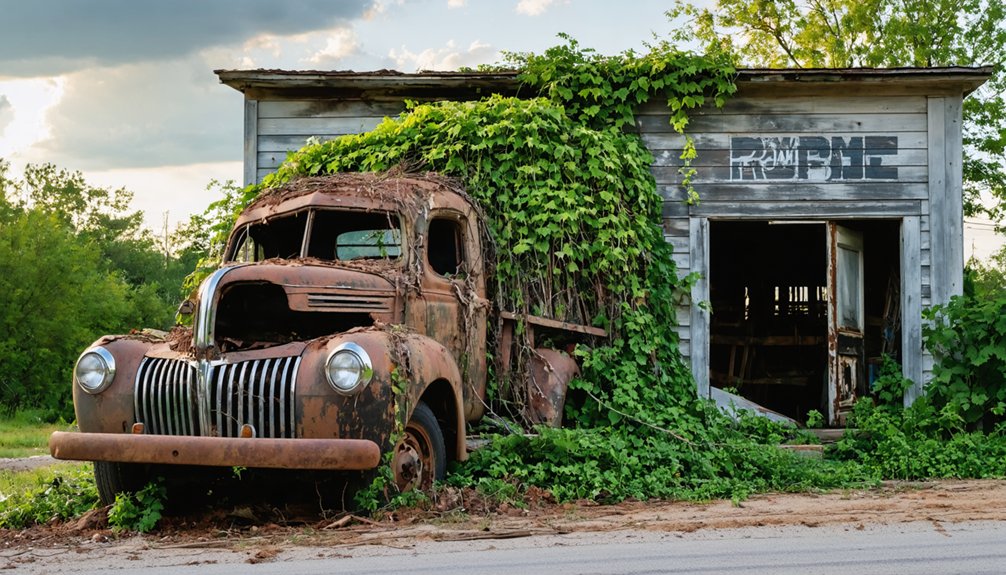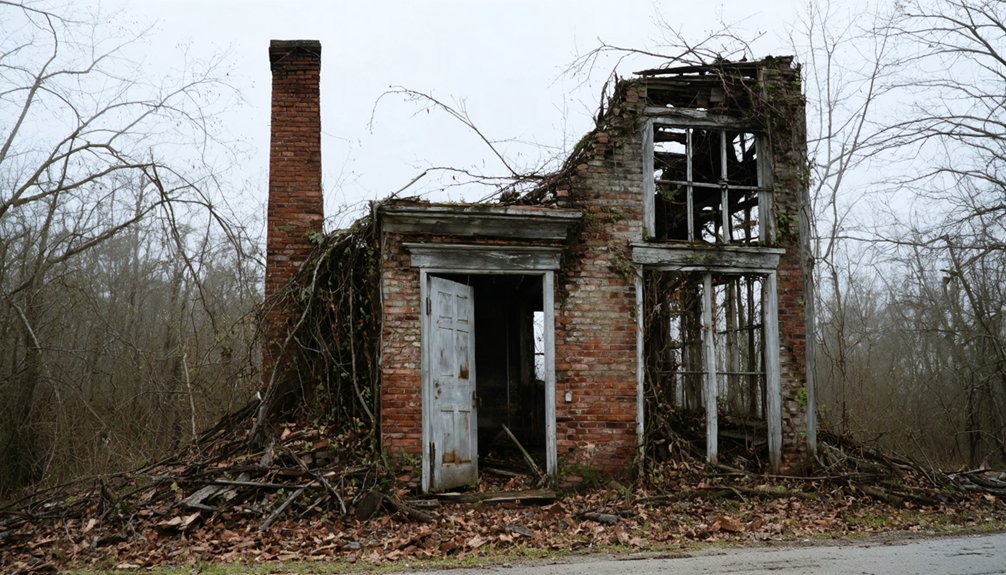You’ll find Bluffton, Alabama’s ruins beneath Weiss Lake today, but in 1888 this boomtown sparked with innovation. After discovering iron ore deposits, the town quickly grew to 8,000 residents, boasting electric streets, Victorian homes, and the grand Signal Hotel. The Smith family’s influence and moonshine operations added colorful chapters to local lore. When resources dwindled by 1934, residents abandoned their homes, leaving mysteries that the lake’s waters now guard.
Key Takeaways
- Bluffton, Alabama was a thriving iron ore mining town established in 1888, reaching nearly 8,000 residents within two years.
- The town’s prosperity centered around four blast furnaces and mining operations until higher-grade deposits were found near Birmingham.
- Weiss Lake submerged the abandoned town in 1961, after most residents had left following economic decline in the 1930s.
- Notable structures included the Signal Hotel and early electrical infrastructure, making Bluffton a pioneer in rural electrification.
- Present-day remnants include scattered Victorian homes, Salem Baptist Church, and industrial traces beneath Weiss Lake’s waters.
The Rise of a Mining Boomtown
When iron ore was discovered in northeastern Alabama, the bustling town of Bluffton emerged in 1888 as a promising mining community. You’d have witnessed a rapid transformation as New England investors poured money into the Bluffton Land, Ore and Furnace Company, bringing mining innovations and modern infrastructure to this Cherokee County boomtown.
Within just two years, nearly 8,000 residents called Bluffton home, drawn by the promise of mineral wealth in iron and zinc deposits. The town showcased its progress with the construction of the prestigious Signal Hotel, which hosted famous guests including writer Rudyard Kipling.
The town quickly established essential services, including a water works system, post office, and school. Railroad connections further accelerated growth, though economic challenges loomed on the horizon. East Tennessee Railway brought new prosperity as it facilitated mining operations and trade throughout the region.
While Bluffton’s development appeared unstoppable, the discovery of superior iron ore deposits near Birmingham would eventually test the town’s resilience.
Life in Alabama’s Electric Pioneer
As rural Alabama lagged behind urban areas in modernization during the early 20th century, Bluffton emerged as an unlikely pioneer in electrical innovation. The electrification impact transformed this mining town into a beacon of rural advancements, showcasing the possibilities of modern living well before the Rural Electrification Administration’s establishment in 1935.
- Electric lights illuminated Bluffton’s streets when many Alabama communities still relied on oil lamps.
- Local businesses thrived with newfound power access, operating modern equipment and extending working hours.
- Homes in Bluffton enjoyed early adoption of electrical appliances, setting new standards for rural comfort.
Farmers initially showed strong resistance to electrical innovations, viewing the new technology with deep suspicion and skepticism.
The town’s visionary approach to electrification mirrored the later achievements of Rural Electrification Administration in 1935, which would go on to transform rural American life nationwide.
- The town’s electrical infrastructure attracted progressive residents and fostered community development.
- Bluffton’s success inspired neighboring communities to pursue similar electrification projects, though many wouldn’t achieve this until decades later.
The Smith Family Legacy
The Smith family cast a long shadow over Bluffton’s history, extending far beyond the town’s electrical innovations. At the center stood William A. “Bell Tree” Smith, a wealthy landowner who ran an infamous moonshine operation from a hollow tree where customers signaled their arrival with a hand bell.
Local lore tells of Bell Tree Smith’s hollow oak speakeasy, where a simple bell ring summoned moonshine in old Bluffton.
Smith’s generosity and hostility defined his life until death near church grounds during an all-day singing event in August 1908.
You’d find him paying taxes on $185,000 worth of property while maintaining a complex reputation: generous to neighbors in need yet fierce in defending his territory.
His son Robert took a darker path, gaining notoriety for two murders, including a gruesome 1917 decapitation.
The family’s community impact reflected the era’s lawless nature, where self-policing ruled and informal power structures dominated. Like many influential families of their time, the Smiths were active in civic organizations including the Pilot Club and Kiwanis Club. Their legacy mixed folklore with fact, as the Smiths wielded influence across Cherokee County’s economic, legal, and social spheres.
From Prosperity to Abandonment
Founded in 1888, Bluffton rapidly transformed from untamed wilderness into a bustling iron mining boomtown of nearly 8,000 residents.
Despite its promising start, you’d have witnessed the town’s economic decline as higher-grade iron was discovered near Birmingham. The community’s resilience couldn’t overcome the harsh reality of dwindling resources and failing businesses. The massive four blast furnaces drove the town’s economy during its peak years. By 1934, when the post office closed its doors, most residents had already dismantled their homes and moved on. The town’s final chapter was written when Weiss Lake submerged it in 1961.
- Signal Hotel’s electric lights once symbolized progress and prosperity
- Railroad connections brought goods and visitors from distant markets
- Two churches served as anchors for the community’s social life
- Local newspaper “Bluffton Mascot” chronicled the town’s daily life
- Residents managed their own security due to distance from county seat
Today, only foundations and old oaks remain where this once-thriving town stood.
Modern Traces of Lost Glory
Modern visitors to Bluffton’s abandoned grounds can still glimpse fragments of its former grandeur beneath nature’s reclaiming touch.
Time stands still in Bluffton’s forgotten corners, where nature slowly embraces the weathered remnants of yesterday’s glory.
You’ll find scattered Victorian homes standing as silent sentinels of the past, while the active Salem Baptist Church remains one of the few surviving community anchors. Recent metal detecting discoveries have yielded several harmonica reeds, suggesting the town once buzzed with music and entertainment. The architectural remnants of the once-proud Signal Hotel, the county’s first electric-lighted building, lie half-hidden among spreading oaks and sweet-gums.
Beneath the forest canopy, industrial traces tell stories of bygone prosperity. You can explore old mine entrances, discover remnants of the area’s first electrical generating plant, and trace forgotten railbeds near the former depot. What was once a thriving mining town of 8,000 residents now stands silent and abandoned.
Metal detecting enthusiasts occasionally unearth coins and buttons, tangible links to Bluffton’s bustling heyday. During winter months, when leaves thin, you’ll spot more ruins emerging from their verdant shroud.
Frequently Asked Questions
What Happened to the Signal Hotel After Bluffton’s Decline?
Like a fading ghost, your once-grand Signal Hotel crumbled into ruins by the 1950s, leaving only foundation stones and oak trees to mark where this historically significant, electricity-pioneering building once proudly stood.
Were There Any Documented Native American Settlements in Bluffton Before Mining Began?
You won’t find documented Native American settlements at Bluffton’s exact location before mining. While historic settlement analysis shows indigenous presence in Cherokee County, specific artifacts haven’t been discovered at the Bluffton site.
How Did Residents Get Their Drinking Water During Bluffton’s Peak Years?
You’d have accessed water through the town’s established water works system, which drew from local surface water sources, while mining infrastructure and wells provided supplemental supply for Bluffton’s 8,000 residents.
What Was the Average Wage for Miners Working in Bluffton?
You’ll find limited specific wage data for Bluffton’s mining economy, though Alabama’s miners faced significant wage disparities during this era, with earnings typically ranging between $11-12 per hour in today’s terms.
Did Any Other Famous Visitors Besides Rudyard Kipling Stay in Bluffton?
Like a faded guestbook with empty pages, you’d find no other verified famous guests at Bluffton besides Kipling. Though local legends claim Edgar Allan Poe visited, that’s historically impossible since he died before the hotel existed.
References
- https://digitalalabama.com/alabama-ghost-towns/bluffton-alabama/13998
- http://samhardin.family/bluf1.htm
- https://www.gadsdentimes.com/story/news/2005/08/30/crudup-bluffton-among-county-ghost-towns/32291305007/
- https://digitalalabama.com/alabama-ghost-towns/alabama-ghost-towns/9449
- https://kids.kiddle.co/Bluffton
- http://samhardin.family/blufhome.htm
- https://en.wikipedia.org/wiki/List_of_ghost_towns_in_Alabama
- https://www.mapquest.com/travel/underwater-ghost-town/
- https://soul-grown.com/how-a-historic-mining-town-became-one-of-alabamas-favorite-parks/
- https://www.youtube.com/watch?v=Zq0zDTIg9-8



